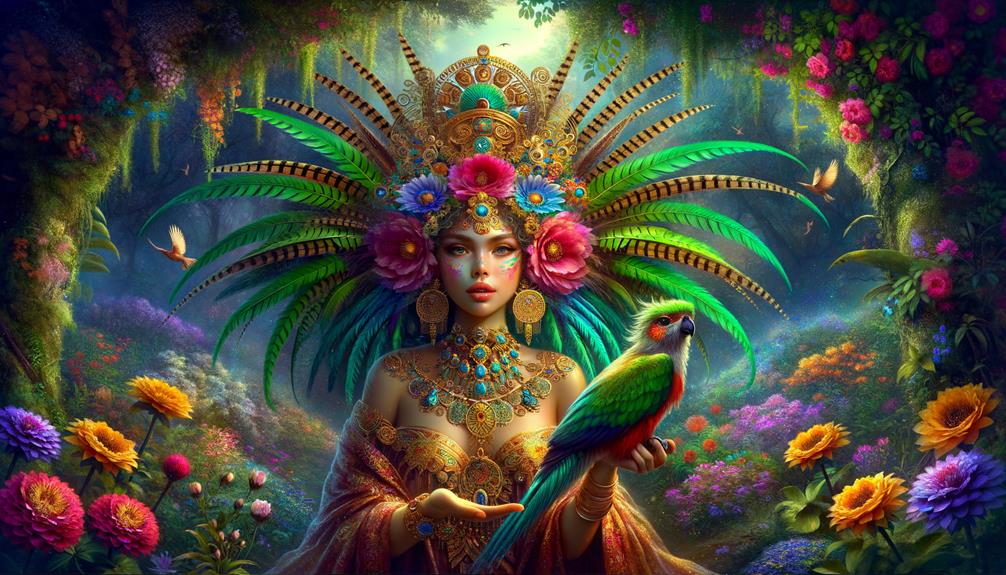Perhaps the Aztec goddess Xochiquetzal embodies more than mere outward glamour that we often associate with her roles in beauty and fertility. By examining her part in nurturing life and artistic expression, we can view her as a representation of perseverance and the sacred feminine spirit, similar to Aphrodite in Greek mythology or Hathor in Egyptian tales. Her influence over fertility rituals and creative outlets hints at a profound, archetypal link between beauty, creation, and the essence of existence itself. What does this reveal about our modern perceptions of beauty and creativity?
Origin and History
Xochiquetzal's story begins in Tamoanchan, the Aztec paradise, where she embodied love and beauty, akin to fertility goddesses across mythologies. Her significance is apparent in ancient texts like the 16th-century Codex Rios, which depict her enduring role in Aztec beliefs. Her mythical background illustrates her divine abilities and relationships with other deities.
Stories of Xochiquetzal's interactions with gods like Tlaloc and Tezcatlipoca, and her son Cinteotl, highlight her central position in the divine hierarchy. These connections symbolize life, fertility, and beauty's interconnectedness in Aztec culture. Xochiquetzal's banishment from Tamoanchan evokes the biblical Adam and Eve tale, adding depth and tragedy to her narrative.
Through these stories, Xochiquetzal emerges as a complex figure whose powers and relationships define her. Her presence in mythology serves as a reminder of archetypal themes resonating across cultures – love, fertility, and beauty's universality.
Characteristics and Traits
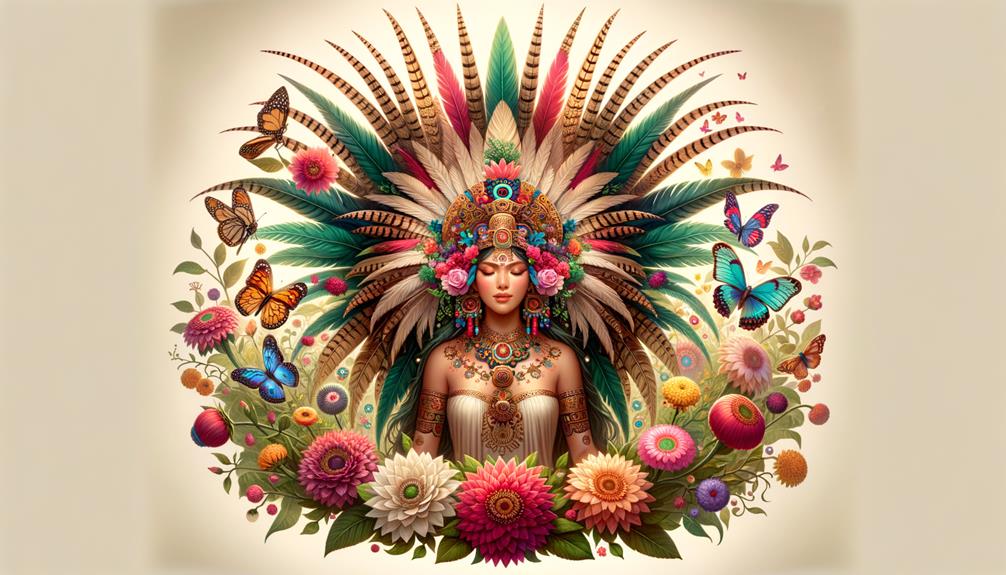
In Aztec legend, the goddess Xochiquetzal exemplifies fertility, sensuality, and creative vitality. She personifies abundant fertility, acclaimed for her alluring charm – representing not only love and beauty but feminine resilience. Her role as guardian of expectant and new mothers highlights her nurturing side, offering support and safeguarding their wellbeing.
Xochiquetzal is often adorned with colorful feathers and vibrant blooms, reflecting nature's radiant beauty and regenerative power. Her presence evokes life's richness, pleasure, and the delicate interplay of strength and allure.
| Essence | Description |
|---|---|
| Fertility | Embodies overflowing fertility and the spark of creation. |
| Love & Beauty | Symbolizes love, beauty, and captivating appeal in Aztec mythology. |
| Feminine Power | Represents fortitude and resilience of the feminine spirit. |
| Nurturer | Revered protector of mothers-to-be and new mothers. |
| Nature's Adornment | Often depicted adorned with vibrant plumage and blooms, echoing nature's bounty. |
Drawing parallels across belief systems, Xochiquetzal's archetypal themes resonate with goddesses of fertility elsewhere, yet she distinctly upholds the Aztec people's singular cultural worldview. Understanding her essence unveils the multifaceted embodiment of life, love, and the creative life force.
Role in Aztec Mythology
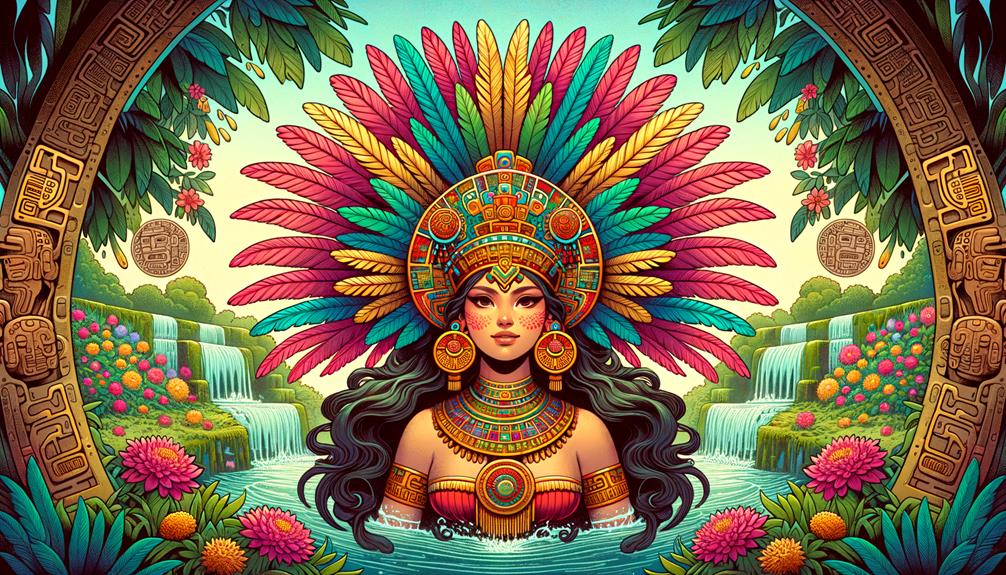
Xochiquetzal played a central role in Aztec mythology as their goddess of beauty, love, and fertility. Her essence intertwined with rituals and everyday life, personifying femininity, creativity, and the vibrant force behind flowers and vegetation. As the guardian of household arts, she embodied nurturing and artistic qualities crucial to domestic traditions.
Xochiquetzal's connections to other gods like Tlaloc, the rain deity, and Tezcatlipoca, the night and sorcery god, added depth to her symbolism. These relationships highlighted her multifaceted nature as not just a beauty and love icon but an integral part of cosmic balance.
Aztec rituals and ceremonies emphasized her archetypal themes:
- Agricultural fertility symbol for bountiful harvests.
- Muse for artistic beauty expressions.
- Presiding deity over matrimonial rites.
- Honored guardian of domestic crafts and traditions.
Xochiquetzal's influence permeated Aztec culture, celebrated through practices rooted in her essence as a life-giving, creative force.
Worship and Rituals
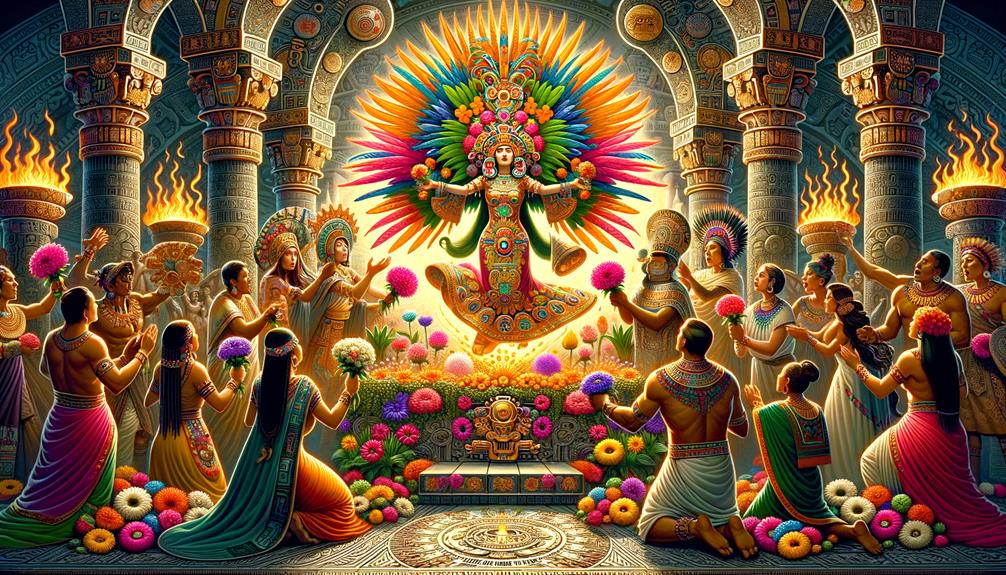
Aztec devotees celebrated Xochiquetzal through elaborate rituals and offerings, highlighting her role as the goddess of beauty and fertility. In their culture, worshipping Xochiquetzal meant revering her as the embodiment of love and feminine power. Temples and shrines were built to honor her, where followers would bring floral arrangements, incense, precious gems, and textiles as offerings. These items symbolized the connection between the physical world and her divine essence.
During festivals like Atamalqualiztli and Tepelhuitl, her influence as the goddess of love and beauty reached its peak. These events featured ceremonies where devotees engaged in ritual cleansings and sexual rites, embracing love and pleasure without judgment. Such practices underscored her role as the patron goddess of sexual rituals, emphasizing the intimate link between human sensuality and divine blessing.
Presenting offerings to Xochiquetzal was a crucial aspect of these ceremonies, reflecting her importance in ensuring fertility and the continuation of life. The rituals celebrated her multifaceted nature, intertwining the appreciation of feminine beauty with the fundamental forces of creation. Through these practices, the Aztecs sought to align themselves with Xochiquetzal's powerful, life-affirming energy.
Symbolism and Legacy
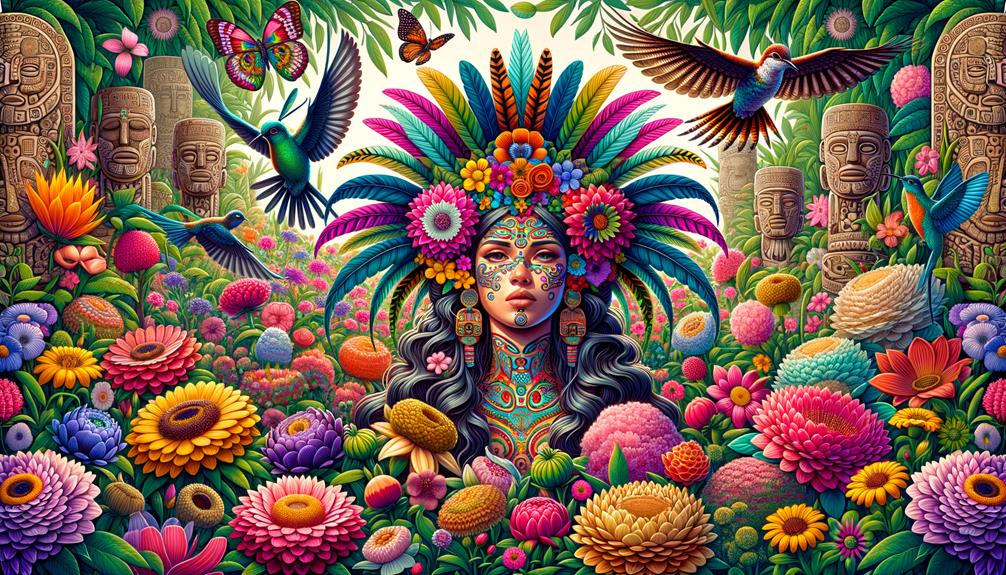
Xochiquetzal, the Aztec goddess, represents the profound bond between feminine spirit, fertility, and beauty. Her archetype reveals a culture that embraced love, pleasure, and sensuality without judgment.
Beyond aesthetics, Xochiquetzal played a pivotal role in rituals of forgiveness, purification, and confession – practices that offered spiritual and emotional healing. Her symbols – flowers, birds, water – illustrate nature's deep connection to creativity and fertility, reinforcing beauty's intrinsic link to the natural world.
As a fertility goddess, she safeguarded life's continuity and growth. Her alluring charm symbolized beauty's magnetic power. She embodied the nurturing, creative, sensual aspects of femininity. Through purification rituals, she guided spiritual cleansing.
Xochiquetzal's enduring legacy pays homage to love, nature, and the captivating power of the feminine spirit.
Frequently Asked Questions
Who Is the Aztec Goddess of Fertility?
In Aztec mythology, Xochiquetzal reigns as the fertility goddess. Her essence intertwines beauty, creativity, and feminine power – universal themes found in similar deities across cultures. Rituals celebrating life and nature were central to her worship.
Does Xochiquetzal Have Kids?
In Aztec myth, Xochiquetzal had offspring like Cintotl, the corn deity. Her children embodied abundance and fertility, playing key roles in rituals celebrating nature's cycles.
Did Xochiquetzal Require Human Sacrifice?
Xochiquetzal's worship didn't involve human sacrifice. Her ceremonies centered around offerings like flowers and incense, highlighting beauty and love – themes distinct from Aztec deities demanding blood sacrifices for appeasement. The goddess represented the archetypal forces of femininity, fertility, and artistic expression through rituals celebrating nature's bounty.
What Animals Are Associated With the Xochiquetzal?
In Aztec folklore, birds like quetzals, doves, and hummingbirds intertwine with butterflies and bees, representing beauty's allure and life's renewal. These creatures reflect divine qualities associated with Xochiquetzal, the goddess of love, fertility, and artistry. Their presence weaves a vibrant narrative celebrating nature's splendor and the cycle of growth.

